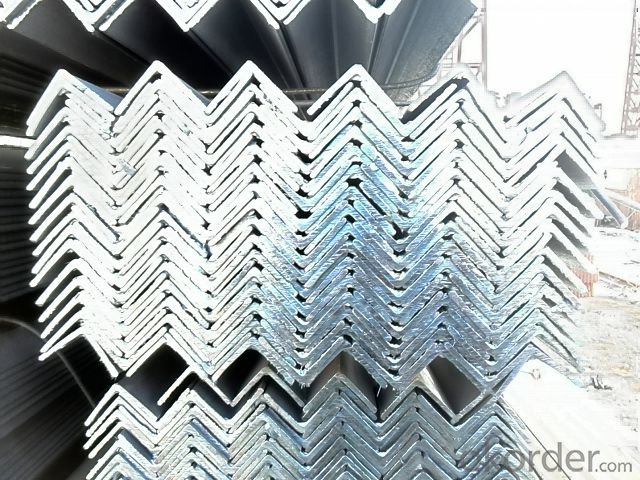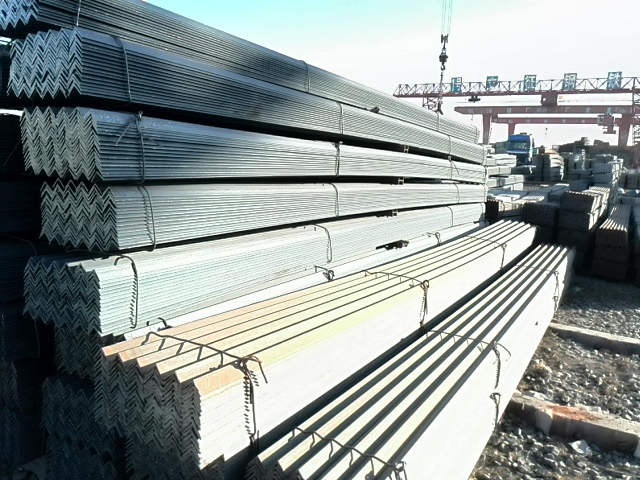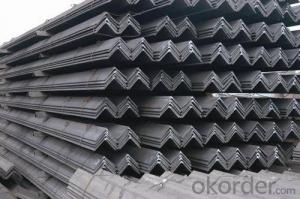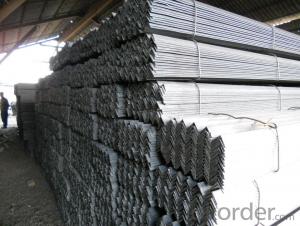Equal Angle Steel Bars with Grade GB-Q235
- Loading Port:
- Tianjin
- Payment Terms:
- TT OR LC
- Min Order Qty:
- 25 m.t.
- Supply Capability:
- 10000 m.t./month
OKorder Service Pledge
OKorder Financial Service
You Might Also Like
Product Description:
OKorder is offering high quality Hot Rolled Equal Angle Steel at great prices with worldwide shipping. Our supplier is a world-class manufacturer of steel, with our products utilized the world over. OKorder annually supplies products to European, North American and Asian markets. We provide quotations within 24 hours of receiving an inquiry and guarantee competitive prices.
Product Applications:
Hot Rolled Equal Angle Steels are ideal for structural applications and are widely used in the construction of buildings and bridges, and the manufacturing, petrochemical, and transportation industries.
Product Advantages:
OKorder's Hot Rolled Equal Angle Steels are durable, strong, and resist corrosion.
Main Product Features:
· Premium quality
· Prompt delivery & seaworthy packing (30 days after receiving deposit)
· Corrosion resistance
· Can be recycled and reused
· Mill test certification
· Professional Service
· Competitive pricing
Product Specifications:
Manufacture: Hot rolled
Grade: Q195 – 235
Certificates: ISO, SGS, BV, CIQ
Length: 6m – 12m, as per customer request
Packaging: Export packing, nude packing, bundled
EQUAL ANGLES SIZES |
| ||
a(mm) | a1(mm) | thickness(mm) | length |
25 | 25 | 2.5---3.0 | 6M/12M |
30 | 30 | 2.5---4.0 | 6M/12M |
38 | 38 | 2.5 | 6M/12M |
38 | 38 | 3.0---5.0 | 6M/12M |
40 | 40 | 3.0---6.0 | 6M/12M |
50 | 50 | 3 | 6M/12M |
50 | 50 | 3.7---6.0 | 6M/9M/12M |
60 | 60 | 5.0---6.0 | 6M/9M/12M |
63 | 63 | 6.0---8.0 | 6M/9M/12M |
65 | 65 | 5.0---8.0 | 6M/9M/12M |
70 | 70 | 6.0---7.0 | 6M/9M/12M |
75 | 75 | 5.0---10.0 | 6M/9M/12M |
80 | 80 | 6.0---10.0 | 6M/9M/12M |
90 | 90 | 6.0---10.0 | 6M/9M/12M |
100 | 100 | 6.0---12.0 | 6M/9M/12M |
120 | 120 | 8.0-12.0 | 6M/9M/12M |
125 | 125 | 8.0---12.0 | 6M/9M/12M |
130 | 130 | 9.0-12.0 | 6M/9M/12M |
140 | 140 | 10.0-16.0 | 6M/9M/12M |
150 | 150 | 10---15 | 6M/9M/12M |
160 | 160 | 10---16 | 6M/9M/12M |
180 | 180 | 12---18 | 6M/9M/12M |
200 | 200 | 14---20 | 6M/9M/12M |
FAQ:
Q1: Why buy Materials & Equipment from OKorder.com?
A1: All products offered byOKorder.com are carefully selected from China's most reliable manufacturing enterprises. Through its ISO certifications, OKorder.com adheres to the highest standards and a commitment to supply chain safety and customer satisfaction.
Q2: What makes stainless steel stainless?
A2: Stainless steel must contain at least 10.5 % chromium. It is this element that reacts with the oxygen in the air to form a complex chrome-oxide surface layer that is invisible but strong enough to prevent further oxygen from "staining" (rusting) the surface. Higher levels of chromium and the addition of other alloying elements such as nickel and molybdenum enhance this surface layer and improve the corrosion resistance of the stainless material.
Q3: Can stainless steel rust?
A3: Stainless does not "rust" as you think of regular steel rusting with a red oxide on the surface that flakes off. If you see red rust it is probably due to some iron particles that have contaminated the surface of the stainless steel and it is these iron particles that are rusting. Look at the source of the rusting and see if you can remove it from the surface.
Images:
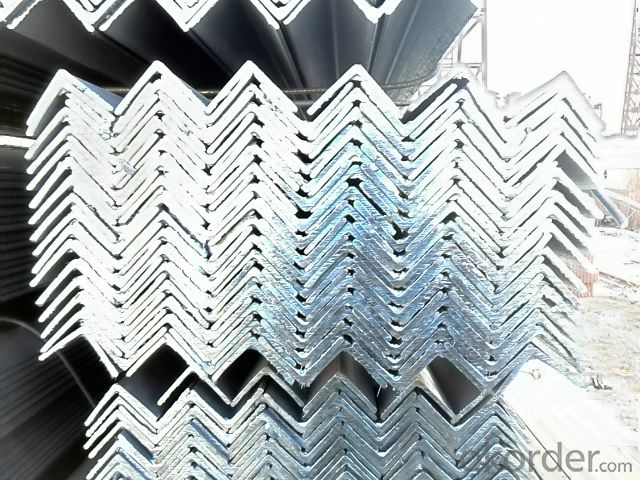
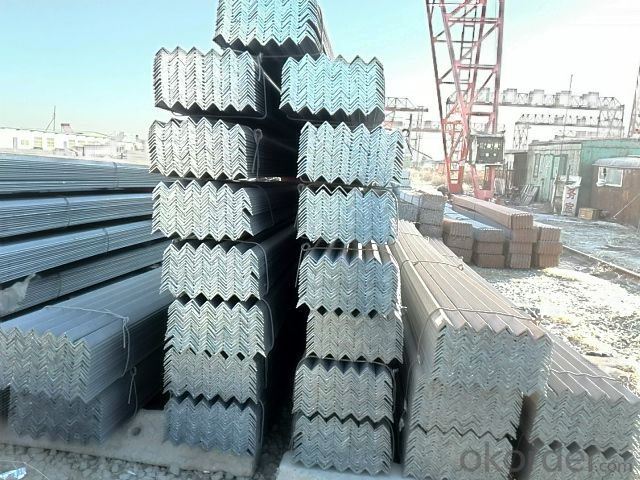
- Q: How do steel angles contribute to the overall stability of a building?
- Steel angles contribute to the overall stability of a building by providing structural support and reinforcement. They are commonly used to reinforce corners and joints in construction, helping to distribute the load and prevent the building from collapsing or experiencing excessive movement during strong winds, earthquakes, or other external forces. The angled shape of steel angles also helps to increase the rigidity and strength of the building's framework, enhancing its overall stability and durability.
- Q: How do you determine the required thickness of a steel angle for a specific load?
- To determine the required thickness of a steel angle for a specific load, several factors need to be considered. Firstly, the load that will be applied to the steel angle must be determined. This can be done by analyzing the structural design or the intended purpose of the steel angle. The load can be in the form of a static load, such as the weight of a structure, or a dynamic load, such as the force exerted by moving objects or wind. Once the load is known, the next step is to calculate the bending moment and shear force that will be experienced by the steel angle. The bending moment is the measure of the bending or flexing of the steel angle under the applied load, while the shear force is the measure of the internal forces that act parallel to the cross-sectional area. The bending moment and shear force calculations are typically performed using engineering principles and formulas, such as the moment of inertia and the maximum stress formula. These calculations take into account the dimensions of the steel angle, the applied load, and the properties of the steel material. Once the bending moment and shear force are determined, the required thickness of the steel angle can be calculated. This calculation involves selecting a suitable safety factor, which is used to account for uncertainties and potential variations in the applied load or the strength of the steel material. The safety factor is usually determined by industry standards or codes. The required thickness can then be calculated using the maximum stress formula, which relates the bending moment, shear force, and the dimensions of the steel angle to the stress experienced by the material. By rearranging the formula, the required thickness can be solved for, ensuring that the steel angle is strong enough to resist the applied load without failing or deforming. In summary, determining the required thickness of a steel angle for a specific load involves analyzing the load, calculating the bending moment and shear force, selecting a safety factor, and using the maximum stress formula to solve for the required thickness. It is important to consult engineering principles, codes, and standards to ensure that the steel angle is appropriately sized to withstand the applied load.
- Q: How to determine the neutral axis of the angle bar?
- For the bolt group, the calculation of the location of the neutral axis is more complex, and is usually approximately assumed on the bottom row of the bolt axis.
- Q: What are the different types of steel angles used in bridge construction?
- Some common types of steel angles used in bridge construction include equal leg angles, unequal leg angles, and L-shaped angles. These angles are often used to provide structural support and reinforcement in various bridge components, such as beams, columns, and bracings.
- Q: Can steel angles be used for shelving units?
- Yes, steel angles can be used for shelving units. Steel angles provide excellent strength and durability, making them suitable for supporting heavy loads on shelves. They can be easily attached to walls or used as a framework for freestanding shelves.
- Q: Can steel angles be used for support brackets?
- Yes, steel angles can be used for support brackets. They are commonly used in construction and engineering projects due to their strength and stability. Steel angles provide structural support and can effectively bear heavy loads, making them a suitable choice for support brackets.
- Q: How do you join steel angles together?
- There are several methods to join steel angles together, depending on the specific requirements and circumstances. Here are some common techniques used: 1. Welding: Welding is a popular and effective method for joining steel angles. It involves melting the edges of the angles together and fusing them using a welding machine. Welding provides strong and durable connections, but it requires skilled personnel and proper safety precautions. 2. Bolting: Bolting is another common way to join steel angles. It involves using bolts, nuts, and washers to connect the angles together. This method provides a secure connection and allows for disassembly if needed. It is relatively straightforward and does not require specialized equipment. 3. Riveting: Riveting is a traditional method that involves using rivets to connect steel angles. It requires drilling holes in the angles and using a rivet gun to secure the rivets. This method provides a strong and permanent connection. 4. Adhesive bonding: Adhesive bonding involves using a strong adhesive to join steel angles together. This method is suitable for lightweight applications and offers the advantage of not requiring heat or specialized equipment. However, it may not be suitable for heavy-duty or high-stress applications. It is important to consider factors such as the load-bearing capacity, structural integrity, aesthetic requirements, and environmental conditions when selecting the appropriate method for joining steel angles together. Additionally, consulting with a professional engineer or fabricator can help ensure the most suitable joining method is chosen for your specific needs.
- Q: Are steel angles resistant to vibrations?
- Yes, steel angles are generally resistant to vibrations due to their rigid and sturdy structure. The inherent strength and stability of steel make it a suitable material for withstanding vibrations caused by various sources.
- Q: What are the different types of steel angles used in machinery?
- There are several different types of steel angles that are commonly used in machinery. One of the most common types is the equal-leg angle, also known as L-shaped or L-angle steel. This angle has equal dimensions on both sides, forming a 90-degree angle. It is commonly used in machinery to provide structural support and stability, as well as to reinforce joints and connections. Another type is the unequal-leg angle, which has different dimensions on each side, resulting in an uneven angle. This type of angle is often used in machinery where specific weight distribution or load-bearing requirements need to be met, as it allows for greater flexibility in design. Additionally, there are also rounded steel angles, also known as rounded corner angles or round bars. These angles have rounded edges instead of sharp corners, making them ideal for machinery applications where safety is a concern, as they reduce the risk of injury from sharp edges. Furthermore, there are slotted steel angles, which have one or more holes or slots along their length. These slots allow for easy adjustment and mounting of components, making them suitable for machinery that requires frequent modifications or customization. Lastly, stainless steel angles are another type commonly used in machinery. Stainless steel offers excellent corrosion resistance, making it ideal for machinery that operates in harsh or corrosive environments, such as marine or chemical applications. Overall, the choice of steel angle in machinery depends on the specific requirements of the application, including structural needs, load-bearing capacity, safety considerations, and environmental factors.
- Q: Can steel angles be used in construction?
- Yes, steel angles can be used in construction. Steel angles are commonly used as structural elements in construction projects due to their strength, durability, and versatility. They are commonly used to support and reinforce various structures such as buildings, bridges, and industrial frameworks. Steel angles provide stability and structural integrity, making them a suitable choice for construction purposes.
Send your message to us
Equal Angle Steel Bars with Grade GB-Q235
- Loading Port:
- Tianjin
- Payment Terms:
- TT OR LC
- Min Order Qty:
- 25 m.t.
- Supply Capability:
- 10000 m.t./month
OKorder Service Pledge
OKorder Financial Service
Similar products
Hot products
Hot Searches



